Morning: At Sea
We were not due to dock at Ternate until around noon. During Thursday morning we were passing a succession of islands to port, each of which seemed to have its own cone-shaped mountain with a much larger island, Halmahera to starboard.
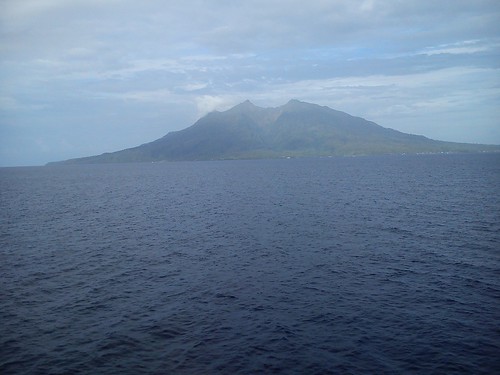 Pulau (Island) Makian viewed fron the ship.
Pulau (Island) Makian viewed fron the ship.
 Pulau Makian as shown on the ECDIS (Electronic Chart Display and Information System), in the bottom left of the screen.
Pulau Makian as shown on the ECDIS (Electronic Chart Display and Information System), in the bottom left of the screen.
At 9.30 a.m. Kathryn gave a presentation entitled ‘Indonesia’s Coastal Sultanates – links between Indonesia and Papua’. The Molucca Islands became important in the sixteenth century when explored by the European mariners, providing Europe with a source of Cloves and Nutmeg, hence the name ‘The Spice Islands’ sometimes used to refer to the Moluccas.
Crossing the Line
Then, just before 11.00 a.m., an imperious voice on the public address summoned all the passengers to the Top Deck. When we were assembled, King Neptune and his court appeared and there was pure pantomime for a while. Apparently, we were ‘Crossing the Line’ and sailing into the northern hemisphere. The Hotel Manager was in attendance and even the Captain put in an appearance. At the end of the slapstick, passengers who had not crossed the equator by ship before were invited to ‘Kiss the Fish’. Fortunately, my sea trip to the Galapagos Islands in 2006 involved 'Crossing the Line' at least twice. There's a rather breathless report on that trip here. After this forfeit had been paid, King Neptune and his entourage returned to their watery underworld.
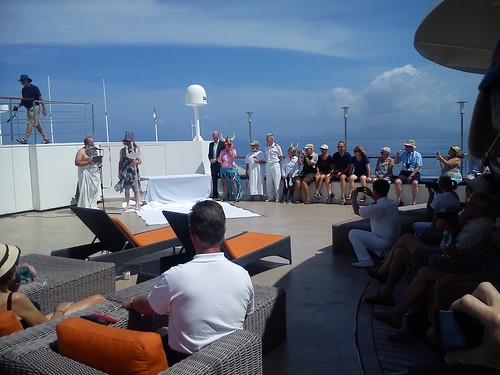 King Neptune, his 'Queen' and Courtiers.
King Neptune, his 'Queen' and Courtiers.
There's a history of this curious tradition in the Wikipedia article Line-crossing ceremony.
Ternate
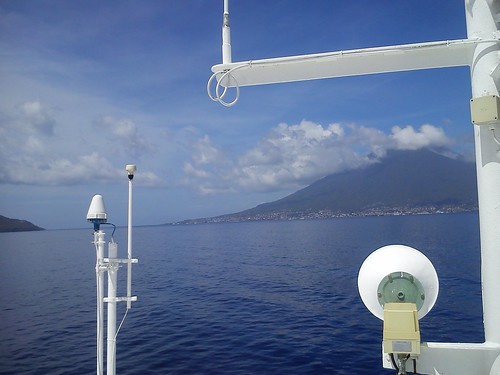 View of Ternate from the Observation Deck of 'Caledonian Sky'.
View of Ternate from the Observation Deck of 'Caledonian Sky'.
The port of Ternate was now ahead, with its own volcano, Mount Gamalama, looming over the town. The volcano is active - the eruption in 1840 destroyed most of the buildings and the most recent activity was in 2011. The population of Ternate is currently about 200,00 but I was surprised to see a number of cargo ships anchored in the approaches.
A small ‘PILOT’ launch came out to meet us and the Port Pilot clambered up the rope ladder put out by our crew. The Port Pilot, of course, assists the Captain in bringing the ship safely to the berth.
 Picking Up the Ternate Port Pilot.
Picking Up the Ternate Port Pilot.
 Approaching the jetty at Port Ternate.
Approaching the jetty at Port Ternate.
We tied-up against a jetty of reinforced concrete carried on concrete piers. I noticed that edges of the concrete dock were crumbling away. We had tied-up opposite a large terminal building with a red-painted corrugated iron roof to which the inscription ‘WELCOME TO PORT TERNATE’ had been added. The gangway had been lowered (after a little delay caused by a mooring bollard being in the way) and, once port formalities had been completed, we were invited to go ashore. Inside the terminal building, a space had been cleared with seats either side for us to watch a different ‘Welcome Dance’ by a group of young men dressed in another traditional costume.
 The 'Welcome Dance' in the terminal building.
The 'Welcome Dance' in the terminal building.
We then divided – one group of passengers drove and hiked to see what is reputed to be the ‘Oldest Clove Tree’, whilst I remained with the larger group which elected to take the ‘Ternate City Tour’. Both groups first went, by coach, to the Sultan’s Palace – a large Colonial villa built by the British.
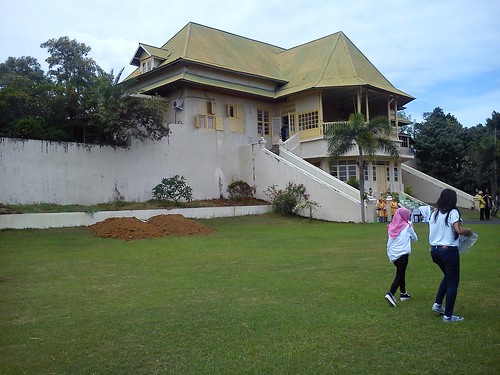 The Sultan's Palace in Ternate.
The Sultan's Palace in Ternate.
A traditional welcoming ceremony was held outside before we entered the Palace to shake hands with the frail-looking white-bearded present Sultan before moving through a Receiving Room with a large wooden throne beneath two parasols and an interesting Reception Room to a large, airy room where we were given sweet tea and a variety of cakes, seated on magnificent wooden furniture.
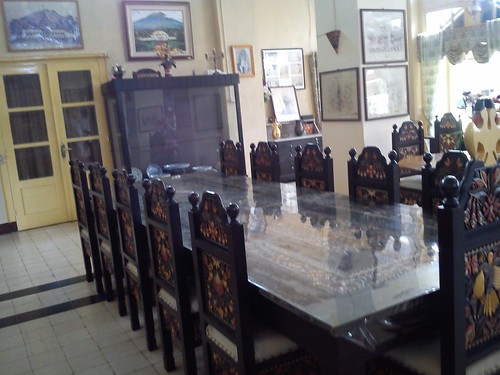 Carved, decorated furniture in the Reception Room.
Carved, decorated furniture in the Reception Room.
The faded glory of the place really appealed to me and I was quite sorry to return to the coach, pausing to look into a 2-vehicle garage holding a rather nice four-wheel carriage, complete with carriage lamps.

The Sultan's Carriage. When I took the picture, I didn't spot the cat.
We drove in our fleet of coaches just out of town to Batu Angus Kulaba Ternate. This is the lava field left by a previous eruption at the point where the lava entered the sea. The barren ‘moonscape’ of huge, black rocks has been rather imaginatively transformed into a memorial park. Lava has been crushed and graded to provide a series of footpaths made of small-diameter lava stone, lined both sides with edging of larger-diameter lava stone. The footpaths lead to two viewpoints overlooking the sea. A variety of trees have been planted, each set inside a white-painted rectangular frame of concrete. At a number of points around the site, the larger-diameter lava stone has been used to build a sort of hollow ‘cairn’ to serve as litter bins. I found the whole arrangement thoughtful and effective.
 One of the viewpoints in the Memorial Park.
One of the viewpoints in the Memorial Park.
Our coaches took us back towards the town, stopping near Fort Tolucco and creating a traffic jam on the narrow road. Fort Tolucco was originally built by the Portuguese but also used by other nations later. Not very much of the fort remains but it still has commanding views of the sea, the town and, inland, the threatening bulk of Mount Gamalama.
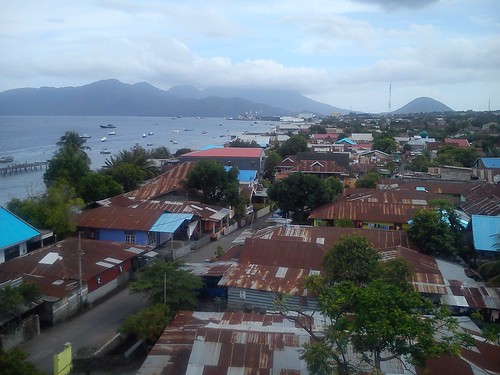 View from Fort Tolucco, showing the town and the sea.
View from Fort Tolucco, showing the town and the sea.
We made a further stop at the former home of Alfred Russel Wallace (1823 – 1913), generally acknowledged as the co-discoverer, with Charles Darwin, of the Theory of Evolution. Although Wallace became famous in his lifetime, his role has been played-down latterly and he is often depicted as a rival to Darwin. In fact, the two biologists remained friends throughout their lives and Wallace was a pall-bearer at Darwin’s funeral. The house is now a private residence but the lady occupier, who appeared to have a number of children, seemed unfazed by the invasion of a large party of foreigners.
 The bungalow-style Wallace House has broad verandahs front and rear.
The bungalow-style Wallace House has broad verandahs front and rear.
The last stop on our tour was at the market. It seemed to be in three parts: a covered market in a fairly modern building, a cramped area of a number of rows of stalls in between the market building and the road and, finally, long rows of stalls on both sides of the busy road actually in the carriageway, where the stallholders sit on the side of the stall away from the road. Shoppers, or just passers-by, are forced to walk further into the carriageway. With fairly heavy traffic in both directions whilst we were there this is, to say the least, interesting. As always, I was struck by the sheer variety of goods on offer and by the friendliness of the people, who found our presence a huge joke. After an interesting but rather hurried visit, we walked back to our waiting coaches (somehow escaping injury from the passing traffic) and were driven back to our ship after a varied and fascinating tour.
 Ternate Market.
Ternate Market.
There's an interesting article in Wikipedia called Ternate which includes a decent map which, at larger size, clarifies the bewildering array of islands.
On to Bitung
We were due to depart at 5.00 p.m. on the 154 nautical mile journey to Bitung. However, we had to await clearance from the Port Authorities who, for some reason, delayed our departure. While we waited, one of the inter-island passenger ferries (which also carry shipping containers on the foredeck) arrived and berthed next to us.
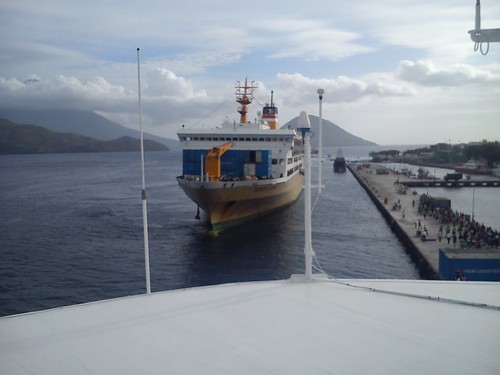 An inter-island ferry berths at Ternate as we await clearance to leave.
An inter-island ferry berths at Ternate as we await clearance to leave.
We were over two hours late leaving and, we were told later, only received clearance after Destination Asia (Noble Caledonia’s Land Agent) contacted the Mayor of Ternate who intervened with the Port Authorities. To maintain our schedule for the following day, the Captain increased our speed overnight. I’ll tell you a little about our visit to Bitung next time.
You can find all the posts on this trip here.
My pictures
Sailing to the Molucca Isles.
Ternate, Molucca Isles.
[Minor revisions, pictures and links added 27-Feb-2015]
